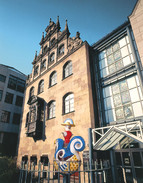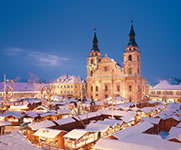Other highlights
Museums

The Germanic National Museum is more than just a museum, it is a "well ordered body of work covering the entire source material for German history, literature and art". Its architectural heart is a late-medieval Carthusian monastery with cloisters, church and monks' cells. The permanent collections are augmented by numerous international exhibitions on special topics. An attractive accompanying programme for children, young people and adults as well as multilingual guided tours of the collections and exhibitions are also available. Closed on Mondays.
The heart of the toy world beats at Nuremberg's famous toy museum. Toys have an eternal appeal to the child in everyone. A new 800m² outdoor area with a range of playthings and a vaulted cellar with a light show are open from May to October. Free crèche in the toy room with professional child minders, multilingual guided tours and tours for children (aged 6 and above) are available. The museum is closed on 24, 25 and 31 December, 1 January, Good Friday and every Monday.
Few other German cities are faced with more reminders of their Nazi past than Nuremberg. Buildings that are reminders of the megalomania of the National Socialists still stand on the former Reichsparteitagsgelände (Nazi Party Rally Grounds) which covers more than four square kilometres. More than 55 years after the end of the Second World War the documentation centre, which opened in 2001, tells the story of the rally grounds and the Nazis' criminal abuse of power. The exhibition focuses on topics with direct relevance to Nuremberg, such as the history of the Nazi Party Rallies, the buildings on the rally grounds, the "Nuremberg Laws" of 1935, the "Nuremberg Trials" of the main Nazi war criminals in 1945/46 and the twelve subsequent trials as well as the difficult task of dealing with the post-1945 legacy of Nazi architecture. Closed Carnival Monday, Shrove Tuesday, 24, 25 and 31 December, multilingual audio guides.
» www.museen.nuernberg.de
The DB Museum, which opened in 1899 as the Royal Bavarian Railway Museum, is the oldest of its kind in Germany. Its amazing collection of historical railway vehicles - ranging from the "Adler" (Eagle), the first German steam locomotive, to the ICE (InterCityExpress) - is on display in the main building and in the vehicle hall inside the grounds. With 160 vehicles, as well as many related exhibits, this collection is the largest of its kind in Germany. The entire history of the German railways is covered, as are all the different types of traction and vehicle ever used on Germany's rails. Young visitors in particular can have fun exploring railway history in the museum's interactive discovery centre (1,000m²). Guided tours in several languages. Closed on Mondays.
» www.db.de
Albrecht Dürer House, built around 1420 near Kaiserburg Castle, was the home and workplace of the world famous Nuremberg artist Albrecht Dürer (1471-1528) from 1509 to 1528. The permanent exhibition covers all aspects of the artist, his life, his home, his work and his artistry. The multivision show in the museum's cinema immerses visitors in the world of "Albertus Durer Noricus" and his work in a completely new way. The artist's studio from Dürer's time is a special attraction. Artistic techniques are demonstrated and visitors can try their hand at painting and drawing. The gallery features temporary exhibitions and important graphic works by Dürer. Closed Mondays except July to September and during the Christmas market, multilingual guided tours
» www.museen-nuernberg.de
Opened in 2000, the museum's 7,800 m² exhibition space is devoted to contemporary art and design in equal measures. The design collection is on the ground floor of the museum and features examples of international design dating from 1945 to the present day selected from its own holdings. Examples of visionary trends in international design and highlights from movements typical of their time are displayed on three parallel time axes following the architectural structure of the space and providing visitors with many different perspectives and cross reference points. Closed on Mondays, Good Friday and 24, 25 and 31 December. Guided tours on request. Accessible for wheelchair users.
» www.nmn.de
The Museum for Communications in the Nuremberg Transport Museum has its origins in the royal Bavarian Post Office Museum. It covers more than 500 years in the history of the mail and communications in Bavaria, from the Middle Ages to the present day and focuses on the development of the postal service, travelling by mail coach, telegraphy and the telephone. Original vehicles such as stagecoaches and motor vehicles as well as technical equipment ranging from early telephones, teleprinters and telex machines to communications satellites are on display. The museum also houses a large collection of films and video tapes. Closed on Mondays, 24, 25 and 31 December, 1 January and Good Friday. Guided tours on request.
» www.museumsstiftung.de
The medieval dungeons dating from the 14th century are located in the vaulted cellars of the magnificent town hall designed by Jakob Wolff in Nuremberg's heyday. The dungeons were not a permanent prison in the modern sense. They were used for people awaiting trial. It was only in exceptional cases that prisoners served their full sentences here. Today, you can still see twelve cells, each of which is two metres long and often housed two prisoners. Wooden boards once covered the floors, walls and ceilings. Each cell contained a plank bed, a bench and a wooden board for a table. A higher room housed the torture chamber, once an essential part of the legal process, which offers an insight into some of the more gruesome aspects of the legal system in the Middle Ages. Famous occupants of this prison include the sculptor Veit Stoss. Closed on Mondays between April and October, closed January, closed on Saturdays and Sundays in February and March, open daily during the Christmas market, guided tours only.
» www.tourismus.nuernberg.de
Travel Planner
Select an option...
Map of Germany
Hotels in Nuremberg
Loading



